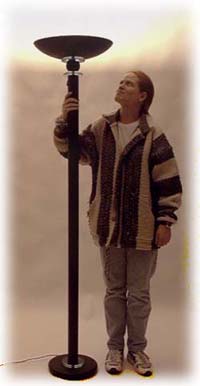New Lighting Fixture Wins Popular Science "Best of What's New " Award
By Allan Chen, a_chen@lbl.govNovember 11, 1997
BERKELEY, CA -- An energy-efficient compact fluorescent lamp torchiere, developed by scientists at Ernest Orlando Lawrence Berkeley National Laboratory's Lighting Research Group, is a grand prize winner in the "Best of What's New" Awards from Popular Science magazine.
The new lamp uses about one quarter of the energy, puts out more light, and is far safer than the popular halogen torchiere. Said Berkeley Lab scientist Michael Siminovitch, who led the team that developed the new fixture, "Imported halogen torchieres use tungsten-based halogen sources in the 300-Watt range. These halogen torchieres have caused one of the largest increases in residential lighting energy use in the U.S. They are consuming more energy than compact fluorescent lamps are saving. They also operate at high temperatures, posing a severe fire hazard. Halogen lamps are essentially heat sources that happen to generate light."

The new compact fluorescent torchiere is a safer, energy-efficient alternative to the imported halogen torchieres, which have caused at least 189 fires and 11 deaths in the U.S., according to the Consumer Product Safety Commission. Compact fluorescent torchiere fixtures are much more energy-efficient than the halogen-based ones, saving consumers about $136 over the lifetime of the lamp.
Popular Science chose to honor the development of the new lighting fixtures as part of its annual "Best of What's New" Awards program. Each year, the magazine's editors examine thousands of new products and discoveries and select the year's 100 most significant achievements in science and technology in 10 categories. The compact fluorescent torchiere was the top winner in its category, Home Technology. The primary criterion for winners, according to the magazine, is that "each innovation must make a positive difference in our lives." This year's winners are being announced at a November 11 ceremony in New York City.
Comparing Berkeley Lab's Lighting Lab's best design, which uses the two 36-Watt compact fluorescent lamps, to a typical 300-Watt imported halogen torchiere, Lab researchers found that the compact fluorescent lamp produced 25 percent more light using one-fourth the energy of the halogen torchiere.
Currently, EMESS Lighting of Pennsylvania is producing the Coolbrite 4000, a CFL torchiere based on the early Berkeley Lab prototypes. University dormitory lighting programs have begun to use the EMESS fixtures extensively. A replacement program at Stanford University last spring was the first demonstration of efficient torchieres in the U.S. Houston's Rice University has the largest efficient torchiere program in the country. It has replaced all of the halogen torchieres in its dormitories, about 1,000, with efficient compact fluorescent models.
